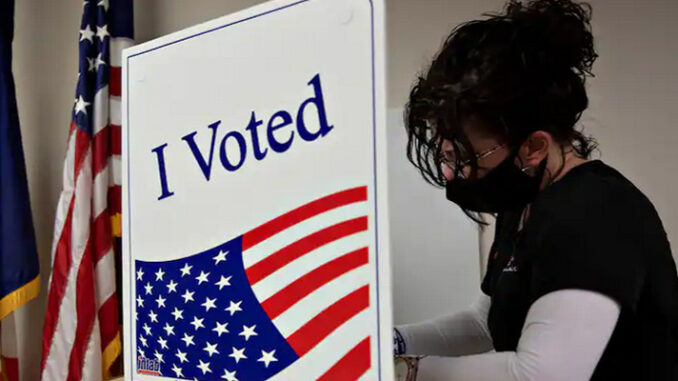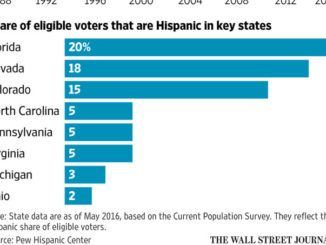
It’s Not As Bad As You Think—It’s Worse
By Ruy Teixeira
The Democrats are steadily losing ground with Hispanic voters. The seriousness of this problem tends to be underestimated in Democratic circles for a couple of reasons: (1) they don’t realize how big the shift is; and (2) they don’t realize how thoroughly it undermines the most influential Democratic theory of the case for building their coalition.
On the latter, consider that most Democrats like to believe that, since a relatively conservative white population is in sharp decline while a presumably liberal nonwhite population keeps growing, the course of social and demographic change should deliver an ever-growing Democratic coalition. It is simply a matter of getting this burgeoning nonwhite population to the polls.
But consider further that, as the Census documents, the biggest single driver of the increased nonwhite population is the growth of the Hispanic population. They are by far the largest group within the Census-designated nonwhite population (19 percent vs. 12 percent for blacks). While their representation among voters considerably lags their representation in the overall population, it is fair to say that voting trends among this group will decisively shape voting trends among nonwhites in the future since their share of voters will continue to increase while black voter share is expected to remain roughly constant.
It therefore follows that, if Hispanic voting trends continue to move steadily against the Democrats, the pro-Democratic effect of nonwhite population growth will be blunted, if not cancelled out entirely, and that very influential Democratic theory of the case falls apart. That could—or should—provoke quite a sea change in Democratic thinking.
Turning to the nature and size of recent Hispanic shifts against the Democrats—it’s not as bad as you think, it’s worse. Here are ten points drawn from available data about the views and voting behavior of this population. Read ‘em and weep.
1. In the most recent Wall Street Journal poll, Hispanic voters were split evenly between Democrats and Republicans in the 2022 generic Congressional ballot. And in a 2024 hypothetical rematch between Trump and Biden, these voters favored Biden by only a single point. This is among a voter group that favored Biden over Trump in 2020 by 26 points according to Catalist (two party vote).
2. In the same poll, Biden’s net approval rating among Hispanics was -12 (42 percent approval/54 percent disapproval), the latest in a string of poor approval ratings among Hispanics. Hispanics in the poll favor Republicans in Congress over Democrats on containing inflation and securing the border. They are strongly negative on the economy, with just 25 percent believing it is headed in the right direction, compared to 63 percent who believe it is headed in the wrong direction.
3. A recent 538 analysis of aggregated poll data shows that, while Biden has lost support among all racial groups in the last 9 months, the decline has been sharpest among Hispanics.
4. In Texas, perhaps the Democrats’ most prized target for their theory of the case, Biden’s ratings among Hispanics have been dreadful. A September Dallas Morning News poll had Biden’s approval rating among Texas Hispanics at an anemic 35 percent vs. 54 percent disapproval–19 points underwater. His approval rating on handling immigration at the border was even worse–29 points underwater. The latter rating is similar to Biden’s rating on the same issue among Texas Hispanics in the more recent Texas Tribune poll.
5. In the hotly-contested 2021 Virginia gubernatorial election, according to the AP-NORC VoteCast survey (more reliable than the highly flawed exit polls), Democrat Terry McAuliffe actually lost the Latino vote and also lost ground among black and “other race’ (chiefly Asian) voters. This deterioration of nonwhite support also can be seen in analysis of precinct-level results.
6. In the 2020 election, Hispanics, after four years of Trump, gave him substantially more support than they did in 2016. According to Catalist, in 2020 Latinos had an amazingly large 16 point margin shift toward Trump. Among Latinos, Cubans did have the largest shifts toward Trump (26 points), but those of Mexican origin also had a 12 point shift and even Puerto Ricans moved toward Trump by 18 points.
7. Latino shifts toward Trump were widely dispersed geographically. Hispanic shifts toward Trump were not confined to Florida (28 points) and Texas (18 points) but also included states like Wisconsin (20 points), Nevada (18 points), Pennsylvania (12 points), Arizona (10 points) and Georgia (8 points).
8. Pew validated voter data indicate particularly poor performance for Biden among working class (noncollege) Hispanics, with these voters giving Trump a remarkable 41 percent of their vote in 2020. A strong working class Hispanic shift is consistent with detailed precinct-level analysis of the 2020 vote in Hispanic (and Asian) neighborhoods released by the New York Times last December. These data assume special significance in light of the unusually heavy working class character of the Hispanic vote (around 80 percent).
9. You can even see the pro-Trump Hispanic shift in New York City. An excellent analysis by Matthew Thomas shows:
Precincts where at least 50% of residents are Hispanic swung toward Trump by 18 points, with a quarter of voters now backing him for reelection. The shift was even more pronounced in precincts where at least 75% of residents are Hispanic, which had a swing of 25 points toward Trump. Out of all the ethnic enclaves in Queens, Hispanic areas showed the largest movement away from Democrats in 2020, a result consistent with national patterns.
10. It is hard to avoid the conclusion that Democrats have seriously erred by lumping Hispanics in with “people of color” and assuming they embraced the activism around racial issues that dominated so much of the political scene in 2020, particularly in the summer. This was a flawed assumption. The reality of the Hispanic population is that they are, broadly speaking, an overwhelmingly working class, economically progressive, socially moderate constituency that cares above all, about jobs, the economy and health care.
For example, in the post-election wave of the Democracy Fund Voter Study Group (VSG) panel survey, well over 70 percent of Hispanic voters rated jobs, the economy, health care and the coronavirus as issues that were “very important” to them. No other issues even came close to this level. Crime as an issue rated higher with these voters than immigration or racial equality, two issues that Democrats assumed would clear the path to big gains among Hispanic voters.
Consistent with this, Latino voters evinced little sympathy with the more radical demands that came to be associated with the Black Lives Matter movement. In VSG data, despite showing support for some specific policing reforms, Hispanics opposed defunding the police, decreasing the size of police forces and the scope of their work and reparations for the descendants of slaves by 2:1 or more. The findings about relatively positive Hispanic attitudes toward police have been confirmed by poll after poll, as concern about crime in their communities has spiked.
An important thing to remember about the Hispanic population is that they are heavily oriented toward upward mobility and see themselves as being able to benefit from available opportunities to attain that. Three-fifths of Latinos in the national exit poll said they believed life would be better for the next generation of Americans.
They are also patriotic. By well over 3:1, Hispanics in the VSG survey said they would rather be a citizen of the United States than any other country in the world and by 35 points said they were proud of the way American democracy works. These findings on patriotism are confirmed by results from the 2020 More in Common Identity and Belonging study, where the views of Hispanics contrasted starkly with the negative views of progressive activists.
Clearly, this constituency does not harbor particularly radical views on the nature of American society and its supposed intrinsic racism and white supremacy. They are instead a patriotic, upwardly mobile, working class group with quite practical and down to earth concerns. Democrats will either learn to focus on that or they will continue to lose ground among this vital group of voters.
.
Ruy Teixeira is a co-editor of the Substack newsletter, The Liberal Patriot. His most recent book is The Optimistic Leftist.



